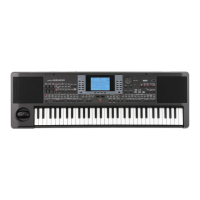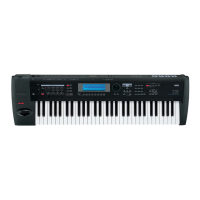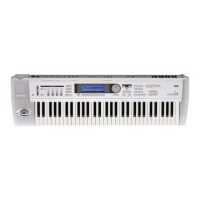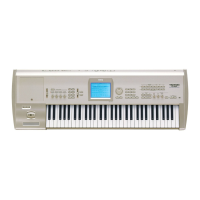Playing and editing Programs
62
Low Boost is a special low-frequency EQ which
controls the body character of the sound. The specific
EQ frequencies affected will change with the Drive
setting.
Higher amounts increase the bass boost, and will also
intensify the effect of the Drive parameter.
X–Y control settings
For details about turning X–Y control on/off or
recording X–Y motion, please see “X–Y controller” on
page 43.
What does X–Y control?
Modulation generally works by moving a single
control. like a slider, in a straight line. At one end of the
control, the modulation is at its minimum; at the other
end, it’s at its maximum.
X–Y control is a little different. It works by moving
around a point on a two-dimensional plane, both left-
right and up-down.
You can think of this point as being positioned on two
different lines at once: a left-right line (the X axis), and
an up-down line (the Y axis).
The X–Y position consists not of a single value (as a
slider) but of two values (X-value and Y-value). Refer
to the following illustration.
X–Y position and X and Y axis values
You can move the position of the point not only by
directly moving the point in the display (X–Y Mode),
but also automatically using X–Y motion, as shown
below.
X–Y motion moving the X–Y position
Volume Control and CC Control
The X–Y control does two main things: it can control
the relative volume of the two Oscillators in Program
mode (or of up to 16 Programs at once in Combination
mode).
The other is to generate CC (MIDI control change)
messages that will modify the program or effect
parameters to change the sound.
X–Y control and MIDI
The X–Y control features interact with MIDI in two
different ways: through the X–Y Mode, and through
the X–Y CC Control.
The X–Y Mode sends and receives two MIDI
controllers: one for the X axis, and the other for the Y
axis. In Global mode, you can assign these to any MIDI
CC numbers you like. The defaults are CC#118 for the
X axis, and CC#119 for the Y axis. X–Y mode (or X–Y
motion) and its MIDI control changes will control the
X–Y position.
The X–Y CC Control, on the other hand, is generated
by the X–Y position. Normally, this will only affect
internal sounds and effects. If you like, however, you
can also enable a Global parameter to send these
generated CCs to external MIDI devices.
+127
+1–127
0
0
Y-Axis
X-Axis
X value: –90
X–Y position
Y value: +50
+127
+127–127
0
0
Y-Axis
X-Axis
X–Y
Volume
Control
X–Y CC
Control
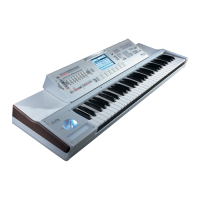
